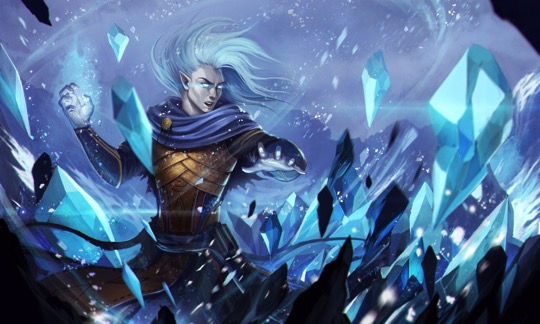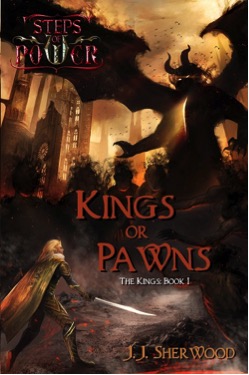My guest today is JJ Sherwood, author of the high fantasy novel, Kings or Pawns, now available in ebook and print.
 On a cold winter night, wind howling into the desert sky, one ordinary hospital gave witness to a historic event. JJ Sherwood was born at 2:30 a.m. on December 31st, just barely managing to squeeze in to supplant New Year’s Eve. JJ has always had a flair for the dramatics. Much of JJ’s childhood was spent tearing through the woods, playing out fantasy worlds, and tying Barbie to the roof so that the Power Rangers might rescue her. Middle and high school carried on this roleplaying, while college encompassed creating and refining over 250 characters in the world of Aersadore. After escaping college, finally armed with the tools of the trade and a lifetime of development, JJ set to writing what would become the Steps of Power series. When not orchestrating the lives and deaths of the people of Aersadore, JJ’s hobbies include drawing, video gaming, wearing a bathrobe, and eating too many baked potatoes. JJ Sherwood lives in Cincinnati, Ohio with one loving and extremely patient spouse, a bearded dragon, a monk parakeet, and four cats who look far too similar.
On a cold winter night, wind howling into the desert sky, one ordinary hospital gave witness to a historic event. JJ Sherwood was born at 2:30 a.m. on December 31st, just barely managing to squeeze in to supplant New Year’s Eve. JJ has always had a flair for the dramatics. Much of JJ’s childhood was spent tearing through the woods, playing out fantasy worlds, and tying Barbie to the roof so that the Power Rangers might rescue her. Middle and high school carried on this roleplaying, while college encompassed creating and refining over 250 characters in the world of Aersadore. After escaping college, finally armed with the tools of the trade and a lifetime of development, JJ set to writing what would become the Steps of Power series. When not orchestrating the lives and deaths of the people of Aersadore, JJ’s hobbies include drawing, video gaming, wearing a bathrobe, and eating too many baked potatoes. JJ Sherwood lives in Cincinnati, Ohio with one loving and extremely patient spouse, a bearded dragon, a monk parakeet, and four cats who look far too similar.
Here now are JJ’s insights on world building.
What is the appeal of world building to you? How does it compare to the importance of character and plot?
World building is one of my absolute favorite aspects of the high fantasy genre. You start with nothing and you have to form a world, continents, oceans, space, constellations, time, races, cultures, languages, histories, and everything a “real world” requires at a level that is both believable and draws others in. A careful balance between realism and fantasy is a delightful challenge.
 On the topic of comparing this world building to character and plot, characters and plot are essential to a story that withstands the test of time, but the world has the ability to fully enrich those characters, their personalities, their histories, their dreams, and the plot that is driven by those characters involved. Everything in Steps of Power is connected—from the moment the world was formed by the gods to the first races that walked the face of Aersadore. The events that took place, the placement of the continents, forests, rivers, and oceans, the tallest mountains, the deepest canyons—all of those weighed in on the languages and cultures of the peoples, their relationships with one another, and ultimately, the protagonists and antagonists that grace the pages. The world is the foundation and strength behind the characters and plot that follows.
On the topic of comparing this world building to character and plot, characters and plot are essential to a story that withstands the test of time, but the world has the ability to fully enrich those characters, their personalities, their histories, their dreams, and the plot that is driven by those characters involved. Everything in Steps of Power is connected—from the moment the world was formed by the gods to the first races that walked the face of Aersadore. The events that took place, the placement of the continents, forests, rivers, and oceans, the tallest mountains, the deepest canyons—all of those weighed in on the languages and cultures of the peoples, their relationships with one another, and ultimately, the protagonists and antagonists that grace the pages. The world is the foundation and strength behind the characters and plot that follows.
For example, in the second novel, Heroes or Thieves, two characters who have done something terrible are forced to leave the elven nation—or risk being discovered and executed. Crossing the Windari Channel is extremely dangerous and nearly impossible by non-sailors. Thus, they crash in a southern desert where they meet a culture of people who have long since been secluded by the landscape from the rest of the continent—thus these people are quite inhospitable. Events continue to spiral downward for the characters involved, based on the way certain magics are viewed, how the landscape is arranged, which races of characters are involved, what the history of the world is up to this point, plus the language, cultures, etc…
Do you have a technique for keeping track of world building as you go? How do you ensure your material is easily retrievable and easy to modify?
World building is a massive undertaking, especially to the degree with which I personally have chosen to go. I’ve been working on Aersadore for almost twenty years—since I was a child. Obviously, aspects have changed greatly over time, but I have had a great deal of time to work with to allow me to shape the world. I use WORD documents, a filing system, notebooks, and calendars to assist me, but ultimately, the content remains in my head and, fortunately, the mind of my editor.
How do you avoid excessive world building and balance it with the act of writing the story?
By keeping the world “real” enough, I do not need to enter excessive world building for readers to enjoy the story. The world is there to enrich everything and draw the reader further in—but information is woven into the histories and behaviors of the characters. I like to start with just those facts, places, and histories that are relevant to the current story and weave in more details as events arise. To build a world as massive as Aersadore, many books are needed—and many books are planned. For example, for about ten books I’ll be focusing on the events that caused the tension between the human and elven races, that divided them across the world, and that slew their great and mutual hero. The way that many of the characters behave and think is weighed on by this great event, and in a future novel, I’ll go back in time and tell the reader what really happened.
Another way I balance world building with the act of writing the story is by utilizing multiple points of views. In Kings or Pawns, there are four main points of view—one from a cynical general of a secluded, northern culture; one from a mute, young servant girl who knows only what others have told her; one from a well-educated and mysterious foreigner; and one from the new, naïve king of the land who had strong ties with the culture and peoples prior to the recent “major event” in the story. By utilizing a variety of histories, cultures, and locations, each point of view can reveal something new and fresh about the world in a natural manner.
How do you balance realism with magic or other world-building elements that allow for departure from the ordinary?
 Magic is one of the most unique and rich elements allotted to the fantasy genre. I choose to have the foundation of my magic based on science—it is well-understood, measurable, and understandable—allowing even those unfamiliar with fantasy to become swiftly comfortable with the magical aspects of the novel. I often choose to use this magic to put individual characters in predicaments that test their resolve, strength of character, or morality. Magic is, sometimes, also used to create aspects of the world that are aweing or terrifying. With the strong foundation in “realism,” these magical elements hold even greater understanding and thus, even greater impact on the reader.
Magic is one of the most unique and rich elements allotted to the fantasy genre. I choose to have the foundation of my magic based on science—it is well-understood, measurable, and understandable—allowing even those unfamiliar with fantasy to become swiftly comfortable with the magical aspects of the novel. I often choose to use this magic to put individual characters in predicaments that test their resolve, strength of character, or morality. Magic is, sometimes, also used to create aspects of the world that are aweing or terrifying. With the strong foundation in “realism,” these magical elements hold even greater understanding and thus, even greater impact on the reader.
My personal favorite magic in the series is healing. I love the threat on a character’s life, but there are many fantasy novels that utilize healing magic to allow characters to escape from death—very often by pulling miraculous healing from an area readers had no idea about. It may be great as a onetime ploy, but when characters survive time and time again, the threat of death wears thin. In order to balance this threat of death and allowance of healing magic, I chose to have the healing magic capable of doing only what the human body can do naturally. There are two essential elements to this healing:
One: if a character suffers some injury of the heart, there is no amount of healing on Aersadore that can ever allow the character’s heart to be as it once was. When a human suffers a heart attack, scar tissue is used by the body to “repair” the heart. It is the same on Aersadore—magic can be utilized to speed up the process of this repair—thus possibly saving an individual’s life—but it cannot be used to reverse the damage.
Two: How quickly and effectively a wound is healed is based entirely on the health and skill of the healer. For example, let’s go with the extreme that someone once asked me to define: What if someone’s arm gets ripped off? Technically, if the arm could be put back exactly where it had been removed and healed quickly enough, the arm could be reattached. However, the human body only has the ability to heal so much at one time before the body runs out of the nutrients it requires to heal. Thus, even if a healer could speed up the healing process of the aforementioned one-armed individual, the person could not possibly recover their arm. Thus, a second element comes into play: the ability of a healer to transfer their own health (nutrients, etc…) to a wounded individual, allowing them to heal past the normal allowed amount. However, this means damage to the healer since they are sending their “health” to the wounded. Thus, such a use of the magic is a double-edged sword and while readers might be thrilled that One Arm gets his arm back, they are now terrified about losing Skilled Healer.
Such physical limitations, as with most magic in the series (although slightly different for other magics) allow for both moral predicaments, tension, and added understanding of the skills and limitations of characters.
How do you deal with contradictions in your story that require large changes to your world? Have you run into this kind of difficult situation and, if so, how did you resolve it?
I have been working on my world for about twenty years before the publication of my first novel—and yet, the undertaking of creating such a massive world means there are bound to be “contradictions.” In order to avoid this, I treat everything I am about to write in the novel as “set in stone.” I carefully consider the information from all angles that it might affect and make a note of it—if signification enough—within the filing. Once the information is “set in stone,” everything that might be affected by it takes it into consideration so as to avoid contradictions. When I’m not certain about the weight of the information I am about to “set in stone,” I write it as simply/vaguely as I can while still retaining the weight of events, but leave it open to expand on later. This also prevents the reader from getting overwhelmed by too much information at once.
Be sure to check out JJ’s high fantasy book, Kings or Pawns:
 The first book in JJ Sherwood’s Steps of Power epic fantasy series. The Kings, Book I: Kings or Pawns is a political intrigue that spirals into an action and adventure series as the final events unfold.
The first book in JJ Sherwood’s Steps of Power epic fantasy series. The Kings, Book I: Kings or Pawns is a political intrigue that spirals into an action and adventure series as the final events unfold.
8,994 P.E.—The elven city of Elvorium has become corrupted to the core by politics. With his father dead and The Royal Schism at his back, Prince Hairem becomes the king of the elven world on Sevrigel. Young and daring, Hairem is determined to undo the council’s power, but quickly finds his loyal council members brutally murdered by an assassin loosed within the city.
As corruption and death threaten to tear the city apart from within, the warlord Saebellus threatens the city from without, laying siege to Sevrigel’s eastern capital. With the elven world crumbling around him, Hairem finds himself in a dangerous political balance between peace and all out war.
Here is a short excerpt:
“General, Saebellus is retreating!!”
Jikun rounded toward his captain’s shout, seeing the soldier stumble from the fray. His captain lurched to the side, black hair plastered to the sides of his pale face as one hand groped for balance on the face of the canyon wall. The captain tore the clasp from the drenched cloak about his neck, letting it fall to the mud beneath his feet. Relieved of its weight, he pushed free of the canyon’s face and shoved Jikun aside, his blade whistling through the air as he swung high to decapitate the soldier behind him.
“I know, damn it!” Jikun shouted in return, eyes narrowing against the onslaught of rain. It bit into his flesh like shards of ice, but in the midst of battle, he was hardly aware of the pain. He stepped forward, willing the meager distance to grant him vision through the torrent of rain. Vision of the enemy that lay ahead. A tremble coursed through the earth as thunder cracked once more. A bolt of lightning lit the towering walls of the surrounding canyon, capturing the deep shadows in the jagged stones and the sunken faces of his weathered troops. “Don’t let him escape!” he bellowed to his soldiers, fighting to be heard above the wind, his throat raw. He shoved forward, leaping over the body of a dying soldier, kicking the grasping arm away from him.
He could see him now.
“Saebellus.”
Kings or Pawns is available now in ebook from:
Amazon | Kobo | Barnes & Noble
Kings or Pawns is also available in paperback from:
Amazon | Barnes & Noble | Steps of Power
And if you’d like to connect with JJ, you can do so in the following ways:
Website: www.StepsofPower.com
Blog: http://www.stepsofpower.com/news.php#toolbar
Twitter: @jj_sherwood
Facebook: https://www.facebook.com/stepsofpower
Email: JJSherwood “at” StepsofPower “dot” com

